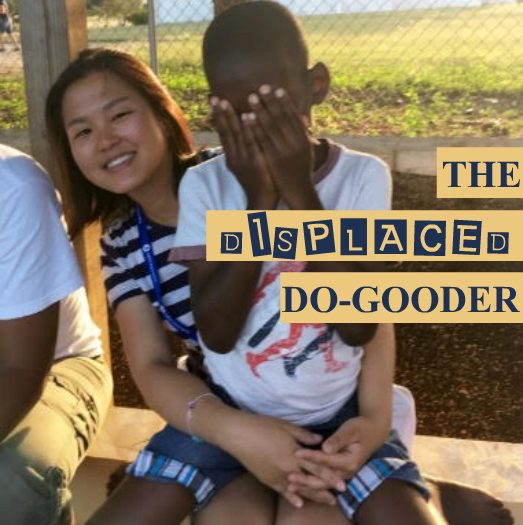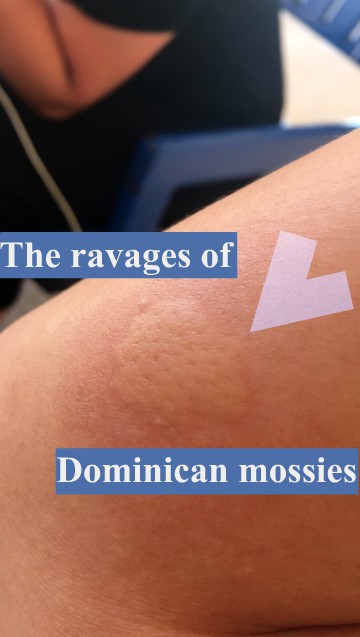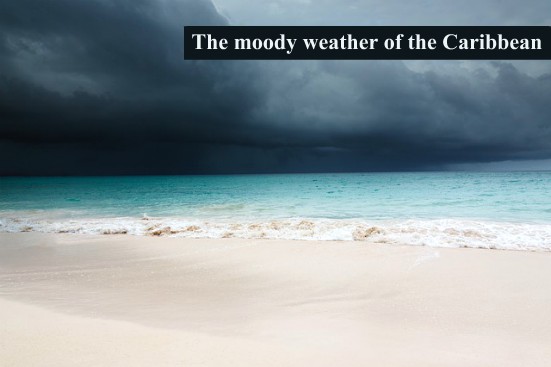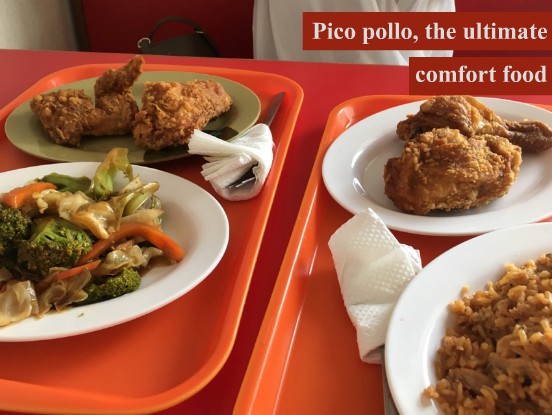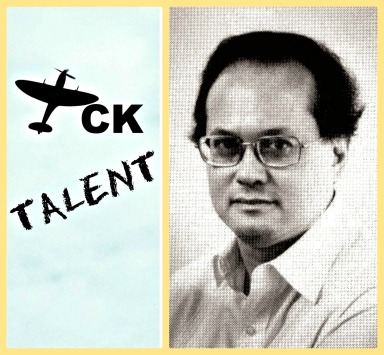
Las Mameyes, Puerto Plata, Dominican Republic (Morguefiles); Lindsay de Feliz (her own photo).
My guest today, the author Lindsay de Feliz, was scuba diving in the Maldives when one night she found herself on a tiny island in the middle of the Indian Ocean gazing up at the stars, the warm water lapping up against her toes.
She thought about life, love and the meaning of the universe. And then she had an epiphany: she no longer wanted the life she had made for herself in the UK. She would leave her husband of ten years, her cats, her house, her cars and her successful career, and buy a one-way ticket to Paradise (she hoped).
“What about your saucepans?” her mother responded upon hearing of this momentous decision. Possibly she was thinking her daughter had gone potty, but instead of saying that, she talked about the set of expensive pans she and Lindsay’s father had bought her for her birthday and Christmas the previous year.
Lindsay did not pack her saucepans and, when she accepted a job as a diving instructor in the Dominican Republic, was glad she didn’t—especially once she’d settled down with her Dominican boyfriend, Danilo. His son, who lived with them as well, had a habit of throwing pans in the bin because he didn’t like washing them.
Yet her mother’s question stuck in her mind, and she decided to write a memoir called What About Your Saucepans?, which was published last year.
I am thrilled to have the chance to talk to Lindsay about this memoir today, which I found an extraordinarily gripping read. Although Lindsay finds her pot of gold in terms of a man who loves her and a life on her own terms, it all goes to pot at a couple of points. And how she copes with these setbacks is as interesting as anything she has to say about the details of life within the country that has the distinction of being the most visited in the Caribbean (though her account of Dominican life is compelling, too).
And now, before we start, can you hear me banging on a saucepan as I yell out: BE SURE TO LEAVE A COMMENT; YOU’LL HAVE A GOOD CHANCE OF WINNING A DIGITAL COPY!
* * *
 Hola, Lindsay. ¿Que lo que? Can we start, please, by having you tell us what prompted your decision to write a memoir after a decade of living in the Dominican Republic?
Hola, Lindsay. ¿Que lo que? Can we start, please, by having you tell us what prompted your decision to write a memoir after a decade of living in the Dominican Republic?
I used to send monthly emails to friends and family about what I was doing and many of them said that I should write a book. I know people often say this, but the longer time went on the more the idea started to grow on me. However, the major prompt was when I was shot by a couple of burglars I’d apprehended at the gate to my home. The bullet passed through my throat and then went straight through my right lung. I made it to the local hospital being carried, then draped over the back of a motorbike, and eventually in a car. After a botched tracheotomy, I was taken to a hospital in the capital, where they put in chest drains. I went home after 12 days.
Wow! So being shot was what motivated you to write about your expat life?
There were lots of things I couldn’t remember about the incident—to this day, my recollections of it are a bit fuzzy—so I asked those who helped me what happened, and then wrote it all down. That became a chapter in the book, and then I filled in before and after.

The bullet went through Lindsay’s lung and got stuck in her back. Here it what it looked like two weeks after the shooting (Lindsay’s own photo).
Did you ever think of writing a novel instead? I ask because your memoir almost reads like a novel. I felt as though I get to know all the characters and missed them when I put the book down.
No, I never thought about writing a novel—my life was like a novel!
I understand the life you left behind in the UK was somewhat more mundane. Can you describe a typical day?
Typically, I would drag myself out of bed at around 5:30 a.m. in the dark. Get showered and dressed in a power suit making sure high heeled shoes and jewelry matched. Wrap up warm and walk 20 minutes to the train station. Train to Central London. Tube to the city. Another tube to Canary Wharf. Total journey time around two hours assuming no delays, which there often were. Work out in the gym and then walk or train to the office. Work all day long, maybe lunch at The Ivy with agencies or journalists, then the same journey home again, getting home around nine and falling into bed to do the same thing the next day.
What was the trigger (so to speak) that made you decide to pack it all in and become a scuba diving instructor?
I adored scuba diving in tropical places and managed to go a few times a year and it just seemed daft to work so hard to pay to go diving when I could dive all the time and earn enough to live off doing something I loved.
How did you end up in the D.R., of all places?
I started off in the Maldives, then went east to Asia, found it impossible to obtain work permits so ended up in Menorca, an island in the Mediterranean belonging to Spain. I decided I should learn Spanish as I already spoke French and German (as an instructor, the more languages you can speak the better). I wanted to get back to the tropics and a job came up in the Dominican Republic, so off I went.
Every pot will find its lid
February is a month for celebrating romance and love. How did you meet Danilo, the Dominican man who became your second husband?
I had seen him around, but I wasn’t even thinking about a relationship. My plan was simply to learn Spanish then head for Costa Rica and work as an instructor there as the diving was supposed to be excellent. One night at a bar Danilo was there and offered me a lift home on his scooter.
Was it love at first sight?
No, although he was seriously cute. But once Dominicans decide that you are the one, they are like Rottweilers and never let you go! He pursued me with a vengeance.

A happy family, Caribbean style: Lindsay with her husband, Danilo, and two sons.
Your courtship led to a ready-made family (his kids) and marriage. Was that a difficult decision?
Not at all. Danilo moved in with me after a couple of weeks courting—as I said they move fast, and as soon as he moved in I was called his “wife” (the vast majority of Dominicans don’t actually get married they just live together but are known as husband and wife). He moved his three children in a week later. We were like that for three years, so most of the big cultural adjustments had already taken place—and there were many, which I discuss in the book. He gave me what I wanted in terms of doing everything to make me happy and to make my life easier, and most of all he made me laugh.
But isn’t “happily ever after” particularly challenging for those of us in cross-cultural marriages?
I must admit, due to the fact we were from such different backgrounds I doubted that we would ever become soul mates, in the way you dream of as a child. However, over the past couple of years—we have now been together for 12 years—he has become my media naranja, as they say here—my half an orange—and is totally my soul mate, my best friend and more. Much I think is due to fact that he is now at university, so we have more “intellectual” conversations, and my Spanish is now much more fluent than it was in the early days. We still laugh all the time and I could not contemplate life without him.
If ifs and ands were pots and pans…
Looking back over the decade you’ve lived in the Dominican Republic, what was your most “displaced” moment: when you thought, what’s a nice girl like me doing in a place full of superstition, political corruption, thievery, and the many other cultural quirks you mention in your book?
You are right, there are many—so many I don’t know where to start. Maybe squatting down to have a pee in the sugar cane fields, taking photographs of dead people in their coffins as their families wanted a picture and had no camera, going into a store and being asked to wait while they catch a rat, going to a jail to get prostitutes out, delivering a baby to a Haitian women on the mud floor of her hut—and of course having been shot, which, although I didn’t realize it at the time, meant being taken to hospital draped over the back of a motorbike because there are no ambulances or emergency services where I live.
Goodness, that’s quite a selection! Can you also pinpoint your LEAST displaced moment, when you felt you were much more comfortable living in that place than in your native UK?
I feel like that every day now as I have become totally adjusted to Dominican life. Dominicans call foreigners like me aplatanado—literally, “like a plantain banana,” signifying we’ve become one of them. Nowadays I don’t care what I wear, no make up, material possessions are not important, I don’t get annoyed if the car is scratched—a whole different set of values to those I had before. Instead of dragging myself out of bed, I leap out, happy to see what the day has to bring. I go downstairs and look across at the mountains and watch the sun rise drinking fabulous Dominican coffee. I have never been happier. I talk in the book about my search for joy. Those moments of pure joy that you experience occasionally. Now here I have them every single day. No one could ask for more.
Could you ever live in the UK again?
No, I could never live in the UK again. In the D.R., there are very few rules, which, while it does give rise to some problems, also means one has the freedom of being able to park wherever you want, smoke a cigarette where you want, not wear a seat belt if you choose not to, and so on. I love that. Also, in the UK, Danilo and I have experienced racism—groups of youths making monkey noises on the trains—because I am white and he is brown. I could never ask him to suffer that. Here we have never been made to feel uncomfortable.
Does your husband feel the same way?
My husband loves the organization in the UK, the fact that people queue, the lack of litter in the street and the trains. But even if we did want to live in the UK, we couldn’t as the new immigration regulations mean that I would have to earn a salary I could never earn, and he would have to speak pretty fluent English, which would be very hard for him.
Panning for a publisher
Moving on to the book: what was the most difficult part of the writing process for you?
The first draft was easy. I tend to think for days about what I want to write—in bed before I go to sleep, when I am walking the dogs… I wait and wait and wait until I am bursting to write it down. It is so satisfying when you actually write then. Just like when you eventually find a toilet when you have been dying for a pee for ages. The hard bit was changing it to incorporate what the publisher and editor wanted. They wanted me to write much more dialogue, which I found hard, and to talk about things I didn’t really want to talk about. I didn’t want to hurt anyone, and in a memoir you really need to tell the truth. They were right, of course, and the book was much much better as a result; but it was difficult for me to describe all of the emotions.
You published with Jo Parfitt of Summertime Publishing. How did that happen?
The path to publishing was not an easy one. I wrote to literary agents and publishers, and some said no and others told me to get it edited and then resubmit—which I did, but it all cost money. I think in some instances they were just helping out their editor mates as they all said no even after I resubmitted it. In the meantime, I’d started a blog of the same name, which began to build me an audience ready for when the book came out. In the end I found Jo Parfitt, who directed me to a great editor, Jane Dean. Between them they knocked me and the book into shape.
What audience did you have in mind for the book, and has it been reaching those people?
Originally, I had in mind people who were interested in the Dominican Republic. Yes, it has been reaching them, but it is constant work to make sure you find them and tell them about the book. Luckily, the reviews have been fabulous and those who read the book have said that everyone should read it, not just those who like the DR.
I agree, I think it appeals on many levels, not just to those with an interest in the Caribbean.
Thank you for saying that. Apart from being about life in the Dominican Republic, it’s a love story, a horror story, it has adventure, and I like to think that it might make some people reevaluate their lives and what is important to them.
Do you have any advice for others who are writing memoirs and hoping to publish them?
Firstly, write the memoir. Do it. It is great fun and also cathartic. Never stop writing at a point where you are stuck or it takes ages to pick it up again. Stop when you know exactly what you want to write next. I would also say don’t give up when you are looking for a publisher, just keep at it. It must have taken me over a year at least to find Jo. And when I did she set me targets to achieve, which gave me a purpose and a goal. You must also be honest with yourself as to whether people will be interested in your story and what it can do for them, not just what it might do for you. And finally, don’t be arrogant and precious when your editor and publisher suggest changes. They know the market a million times better than you. Take their suggestions on board. In the end it will produce something much better than you could on your own.
10 Questions for Lindsay de Feliz
Finally, I’d like to ask a series of questions that I’ve asked some of our other featured authors, about your reading and writing habits:
1. Last truly great book you read: In the Time of the Butterflies, by Julia Alvarez, a historical novel about the Mirabal sisters, who opposed the dictatorship of Rafael Trujillo in the Dominican Republic.
2. Favorite literary genre: Murder mystery
3. Reading habits on a plane: I haven’t been on a plane since Kindles and such like came out(!). But I used to read novels—the latest Patricia Cornwell or Tom Clancy—which I would buy at the airport.
4. The one book you’d require President Obama to read, and why: Mine. Because I know he would enjoy it, it would make him smile and help him to understand all of the Dominicans in the USA. He would also enjoy the part about Dominican politics. I can just see him reading bits of it to Michelle in bed in his stripey pajamas and them both laughing.
5. Favorite books as a child: Enid Blyton‘s The Famous Five series; the What Katy Did series by Sarah Chauncey Woolsey, under her pen name Susan Coolidge; Heidi; and books about horses and ballet dancers. As I moved into my teens I loved Georgette Heyer books.
6. Favorite heroine: Lisbeth Salander in The Girl with the Dragon Tattoo
7. The writer, alive or dead, you’d most like to meet: This is someone who hasn’t yet published a book so I hope that counts: Aisha Ashraf. Her writing simply blows me away and I could never write like she does. I am a story teller and she has a way of touching your heart. I would love to meet her one day.
8. Your reading habits: I don’t read as much as I would like now. However, when the electricity goes off (which it does here quite a lot) I grab a book and devour it. I also read books online by other Summertime authors which they send to me.
9. The book you’d most like to see made as a film: Mine again! I know it would make a great film. My dream is to go to the Oscars. I just need to make it happen.
10. The book you plan to read next: Linda Janssen’s The Emotionally Resilient Expat. She is another Summertime author, and I am really looking forward to getting into this one.
* * *
Thanks so much, Lindsay. Readers, what I love about Lindsay is her attitude. Some of us might think that she went out of the frying pan (a life she could no longer stand in the UK) and into the fire (getting shot in the Caribbean), but she doesn’t see it that way at all. In fact, as she explains in the book, after surviving the shooting, she has even more purpose in life and even more devotion to her adopted home.
So, any COMMENTS or QUESTIONS for Lindsay? Do you think you would react in the same way to hardships?
And don’t forget, there’s a copy of the book to be won for the best comment! NOTE: If you can’t wait to read the book or don’t win, What About Your Saucepans? is available from Amazon, Apple iTunes, Kobo and Barnes and Noble. And you can also start following Lindsay on her blog, of course!
STAY TUNED for tomorrow’s post, another episode in the life of our fictional expat heroine, Libby, told from the point of view of her husband, Oliver—a rare treat! (What, not keeping up with Libby? Read the first three episodes of her expat adventures.)
If you enjoyed this post, we invite you to register for The Displaced Dispatch, a round up of weekly posts from The Displaced Nation, with seasonal recipes, book giveaways and other extras. Register for The Displaced Dispatch by clicking here!
Related posts:
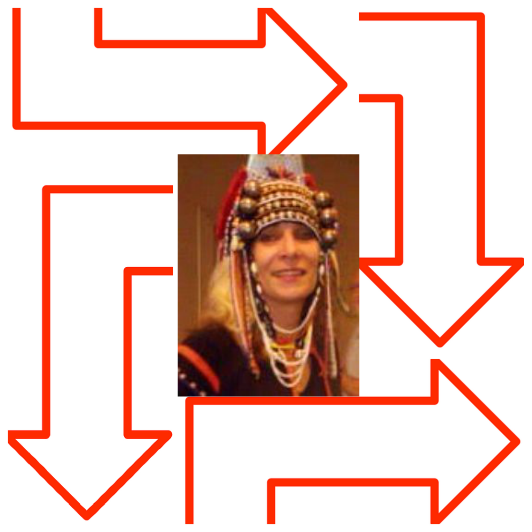


 In South Africa, at
In South Africa, at 










